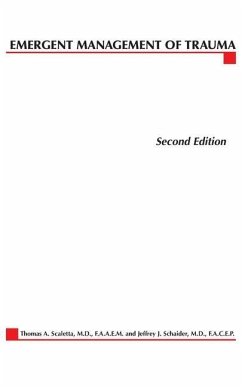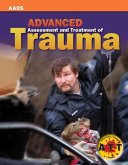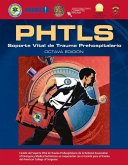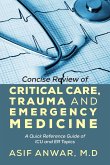- Broschiertes Buch
- Merkliste
- Auf die Merkliste
- Bewerten Bewerten
- Teilen
- Produkt teilen
- Produkterinnerung
- Produkterinnerung
*Mini Drug Formulary includes the latest antibiotics
Andere Kunden interessierten sich auch für
![A-Z of Musculoskeletal and Trauma Radiology A-Z of Musculoskeletal and Trauma Radiology]() James R D MurrayA-Z of Musculoskeletal and Trauma Radiology125,99 €
James R D MurrayA-Z of Musculoskeletal and Trauma Radiology125,99 €![Advanced Assessment and Treatment of Trauma Advanced Assessment and Treatment of Trauma]() American Academy of Orthopaedic Surgeons (Aaos)Advanced Assessment and Treatment of Trauma141,99 €
American Academy of Orthopaedic Surgeons (Aaos)Advanced Assessment and Treatment of Trauma141,99 €![The Emergency Medicine Trauma Handbook The Emergency Medicine Trauma Handbook]() The Emergency Medicine Trauma Handbook89,99 €
The Emergency Medicine Trauma Handbook89,99 €![Phtls Spanish: Soporte Vital de Trauma Prehospitalario Phtls Spanish: Soporte Vital de Trauma Prehospitalario]() National Association of Emergency Medical Technicians (Naemt)Phtls Spanish: Soporte Vital de Trauma Prehospitalario77,99 €
National Association of Emergency Medical Technicians (Naemt)Phtls Spanish: Soporte Vital de Trauma Prehospitalario77,99 €![Handbook of Trauma for Southern Africa Handbook of Trauma for Southern Africa]() Handbook of Trauma for Southern Africa48,99 €
Handbook of Trauma for Southern Africa48,99 €![Brain Control of Responses to Trauma Brain Control of Responses to Trauma]() Brain Control of Responses to Trauma85,99 €
Brain Control of Responses to Trauma85,99 €![Concise Review of Critical Care, Trauma and Emergency Medicine Concise Review of Critical Care, Trauma and Emergency Medicine]() Asif AnwarConcise Review of Critical Care, Trauma and Emergency Medicine19,99 €
Asif AnwarConcise Review of Critical Care, Trauma and Emergency Medicine19,99 €-
-
-
*Mini Drug Formulary includes the latest antibiotics
Hinweis: Dieser Artikel kann nur an eine deutsche Lieferadresse ausgeliefert werden.
Hinweis: Dieser Artikel kann nur an eine deutsche Lieferadresse ausgeliefert werden.
Produktdetails
- Produktdetails
- Verlag: McGraw Hill LLC
- 2nd edition
- Seitenzahl: 644
- Erscheinungstermin: 20. Dezember 2000
- Englisch
- Abmessung: 201mm x 117mm x 23mm
- Gewicht: 558g
- ISBN-13: 9780071345682
- ISBN-10: 007134568X
- Artikelnr.: 21373456
- Herstellerkennzeichnung
- Libri GmbH
- Europaallee 1
- 36244 Bad Hersfeld
- gpsr@libri.de
- Verlag: McGraw Hill LLC
- 2nd edition
- Seitenzahl: 644
- Erscheinungstermin: 20. Dezember 2000
- Englisch
- Abmessung: 201mm x 117mm x 23mm
- Gewicht: 558g
- ISBN-13: 9780071345682
- ISBN-10: 007134568X
- Artikelnr.: 21373456
- Herstellerkennzeichnung
- Libri GmbH
- Europaallee 1
- 36244 Bad Hersfeld
- gpsr@libri.de
Thomas A. Scaletta, MD, Chair, Department of Emergency Medicine, West Suburban Hospital Medical Center, Oak Park, Illinois.
Part I: Resuscitation Concepts.
Chapter 1. Prehospital Issues.
Chapter 2. Hospital Organization.
Chapter 3. Patient Evaluation.
Chapter 4. Airway Management.
Chapter 5. Shock.
Chapter 6. Fluids.
Part II: Anatomic Areas of Injury.
Chapter 7. Head.
Chapter 8. Eye.
Chapter 9. Face.
Chapter 10. Spine.
Chapter 11. Neck.
Chapter 12. Chest: Blunt.
Chapter 13. Chest Penetrating.
Chapter 14. Abdomen: Blunt.
Chapter 15. Abdomen: Penetrating.
Chapter 16. Pelvis.
Chapter 17. Genitourinary.
Part III: Extremity Trauma.
Chapter 18. Soft Tissue.
Chapter 19. Hand.
Chapter 20. Wrist.
Chapter 21. Forearm.
Chapter 22. Elbow.
Chapter 23. Humerus.
Chapter 24. Shoulder and Clavicle.
Chapter 25. Hip and Femur.
Chapter 26. Knee.
Chapter 27. Leg and Ankle.
Chapter 28. Foot.
Part IV: Special Groups.
Chapter 29. Children.
Chapter 30. Pregnancy.
Chapter 31. Elderly.
Part V: Environmental Issues.
Chapter 32. Burns.
Chapter 33. Near Drowning.
Chapter 34. Temperature Extremes.
Chapter 35. Terrorism Preparation.
Chapter 36. Nuclear.
Chapter 37. Biologics.
Chapter 38. Chemicals.
Part VI: Useful Resources.
Chapter 39. Procedures.
Chapter 40. Radiograph Evaluation.
Chapter 41. Radiograph Anatomy.
Chapter 42. Organ Procurement.
Chapter 43. Infection Procurement.
Chapter 44. Aftercare Instructions.
Chapter 45. Drug Formulary.
Chapter 46. Management Algorithms.
Chapter 1. Prehospital Issues.
Chapter 2. Hospital Organization.
Chapter 3. Patient Evaluation.
Chapter 4. Airway Management.
Chapter 5. Shock.
Chapter 6. Fluids.
Part II: Anatomic Areas of Injury.
Chapter 7. Head.
Chapter 8. Eye.
Chapter 9. Face.
Chapter 10. Spine.
Chapter 11. Neck.
Chapter 12. Chest: Blunt.
Chapter 13. Chest Penetrating.
Chapter 14. Abdomen: Blunt.
Chapter 15. Abdomen: Penetrating.
Chapter 16. Pelvis.
Chapter 17. Genitourinary.
Part III: Extremity Trauma.
Chapter 18. Soft Tissue.
Chapter 19. Hand.
Chapter 20. Wrist.
Chapter 21. Forearm.
Chapter 22. Elbow.
Chapter 23. Humerus.
Chapter 24. Shoulder and Clavicle.
Chapter 25. Hip and Femur.
Chapter 26. Knee.
Chapter 27. Leg and Ankle.
Chapter 28. Foot.
Part IV: Special Groups.
Chapter 29. Children.
Chapter 30. Pregnancy.
Chapter 31. Elderly.
Part V: Environmental Issues.
Chapter 32. Burns.
Chapter 33. Near Drowning.
Chapter 34. Temperature Extremes.
Chapter 35. Terrorism Preparation.
Chapter 36. Nuclear.
Chapter 37. Biologics.
Chapter 38. Chemicals.
Part VI: Useful Resources.
Chapter 39. Procedures.
Chapter 40. Radiograph Evaluation.
Chapter 41. Radiograph Anatomy.
Chapter 42. Organ Procurement.
Chapter 43. Infection Procurement.
Chapter 44. Aftercare Instructions.
Chapter 45. Drug Formulary.
Chapter 46. Management Algorithms.
Part I: Resuscitation Concepts.
Chapter 1. Prehospital Issues.
Chapter 2. Hospital Organization.
Chapter 3. Patient Evaluation.
Chapter 4. Airway Management.
Chapter 5. Shock.
Chapter 6. Fluids.
Part II: Anatomic Areas of Injury.
Chapter 7. Head.
Chapter 8. Eye.
Chapter 9. Face.
Chapter 10. Spine.
Chapter 11. Neck.
Chapter 12. Chest: Blunt.
Chapter 13. Chest Penetrating.
Chapter 14. Abdomen: Blunt.
Chapter 15. Abdomen: Penetrating.
Chapter 16. Pelvis.
Chapter 17. Genitourinary.
Part III: Extremity Trauma.
Chapter 18. Soft Tissue.
Chapter 19. Hand.
Chapter 20. Wrist.
Chapter 21. Forearm.
Chapter 22. Elbow.
Chapter 23. Humerus.
Chapter 24. Shoulder and Clavicle.
Chapter 25. Hip and Femur.
Chapter 26. Knee.
Chapter 27. Leg and Ankle.
Chapter 28. Foot.
Part IV: Special Groups.
Chapter 29. Children.
Chapter 30. Pregnancy.
Chapter 31. Elderly.
Part V: Environmental Issues.
Chapter 32. Burns.
Chapter 33. Near Drowning.
Chapter 34. Temperature Extremes.
Chapter 35. Terrorism Preparation.
Chapter 36. Nuclear.
Chapter 37. Biologics.
Chapter 38. Chemicals.
Part VI: Useful Resources.
Chapter 39. Procedures.
Chapter 40. Radiograph Evaluation.
Chapter 41. Radiograph Anatomy.
Chapter 42. Organ Procurement.
Chapter 43. Infection Procurement.
Chapter 44. Aftercare Instructions.
Chapter 45. Drug Formulary.
Chapter 46. Management Algorithms.
Chapter 1. Prehospital Issues.
Chapter 2. Hospital Organization.
Chapter 3. Patient Evaluation.
Chapter 4. Airway Management.
Chapter 5. Shock.
Chapter 6. Fluids.
Part II: Anatomic Areas of Injury.
Chapter 7. Head.
Chapter 8. Eye.
Chapter 9. Face.
Chapter 10. Spine.
Chapter 11. Neck.
Chapter 12. Chest: Blunt.
Chapter 13. Chest Penetrating.
Chapter 14. Abdomen: Blunt.
Chapter 15. Abdomen: Penetrating.
Chapter 16. Pelvis.
Chapter 17. Genitourinary.
Part III: Extremity Trauma.
Chapter 18. Soft Tissue.
Chapter 19. Hand.
Chapter 20. Wrist.
Chapter 21. Forearm.
Chapter 22. Elbow.
Chapter 23. Humerus.
Chapter 24. Shoulder and Clavicle.
Chapter 25. Hip and Femur.
Chapter 26. Knee.
Chapter 27. Leg and Ankle.
Chapter 28. Foot.
Part IV: Special Groups.
Chapter 29. Children.
Chapter 30. Pregnancy.
Chapter 31. Elderly.
Part V: Environmental Issues.
Chapter 32. Burns.
Chapter 33. Near Drowning.
Chapter 34. Temperature Extremes.
Chapter 35. Terrorism Preparation.
Chapter 36. Nuclear.
Chapter 37. Biologics.
Chapter 38. Chemicals.
Part VI: Useful Resources.
Chapter 39. Procedures.
Chapter 40. Radiograph Evaluation.
Chapter 41. Radiograph Anatomy.
Chapter 42. Organ Procurement.
Chapter 43. Infection Procurement.
Chapter 44. Aftercare Instructions.
Chapter 45. Drug Formulary.
Chapter 46. Management Algorithms.








